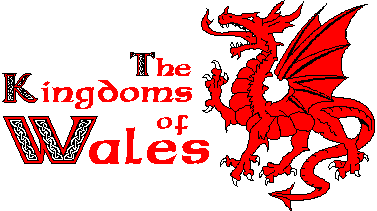
EBK Home
Kingdoms
Royalty
Saints
Pedigrees
Archaeology
King Arthur
Mail David

The Kingdoms of what is now modern Wales came about by several means after Roman officialdom left the British shores. The Irish began to immigrate on a grand scale. The sons of the Emperor Magnus Maximus used them to keep control of Southern Wales. While North Wales was taken by Cunedda Wledig who was intent on driving the Irish out. Eastern Wales and the adjoining area of what became England was the homeland of the usurper, Vortigern, and here his sons continued to hold sway.
Magnus Maximus & South Wales
Magnus Maximus, or Macsen Wledig as he was known to the British, was a general in the Roman Army stationed in Wales. "Wledig" means Land-Holder or Imperator. His background, possibly maternal, was Spanish, but he was also said to have been a descendant of the Emperor Constantine the Great. As Roman control over the Western Empire began to break down in the late 4th century, Magnus was chosen by his men as Emperor of Britain & Gaul. He travelled to Gaul to pursue his claims but was killed in Italy in AD 388. His family remained behind in Britain and later took on the government of the major Roman towns in the Emperor's Welsh powerbase. Magnus' son, Constantine seems to have failed to establish a dynasty in Gwynedd; whilst Eugenius "Black-Lips" (alias Owain Finddu), founded the original dynasty of Mid-South Wales, later called Glywysing (alias Morgannwg). All other monarchies of South Wales descend from their brother Antonius Donatus Gregorius (alias Anwn Dynod). From Maximus descend the Kings of:
- Glywysing (House of Finddu)
- Dyfed
- Brycheiniog
- Gwent & Glywysing (House of Dynod)
- Ergyng
Cunedda & North Wales
Cunedda (or Cunedag) was a northern British chieftain, a sub-King of Gododdin who ruled Manau Gododdin on the Firth of Forth around Clackmannan. He was requested by the northern Welsh to help them expel the invading Irish from their lands, and he eagerly obliged. With his many 'sons,' Cunedda settled down in the area and founded a number of Royal dynasties:
- Gwynedd
- Rhôs
- Ceredigion
- Meirionydd
- Dunoding
- Dogfeiling
- Rhufoniog
- Edeyrnion
- Afflogion
- Osfeilion
Vortigern & East Wales
Vortigern's family had lived in Glevum (Gloucester) before the Romans departed. Being a man of some influence in the town, Vortigern had managed to impose himself as the local leader in the area and, before long, he had taken control of the whole country as High-King of Britain. He is known to the Welsh as Gwrtheyrn Gwertheneu (Vortigern the Thin). As a man with no Imperial connections, he was viewed as a usurper by Roman legitimists, though he tried to consolidate his position by marrying a daughter of Magnus Maximus. His downfall is closely entwined with the story of the coming of the Saxons and the rise of the House of the great King Arthur. However, even after his death, his sons managed to retain control of his central power-base to the west and north of Gloucester, and founded the Kingdoms of:
- Gwent (House of Fendigaid)
- Powys
- Buellt & Gwerthrynion
